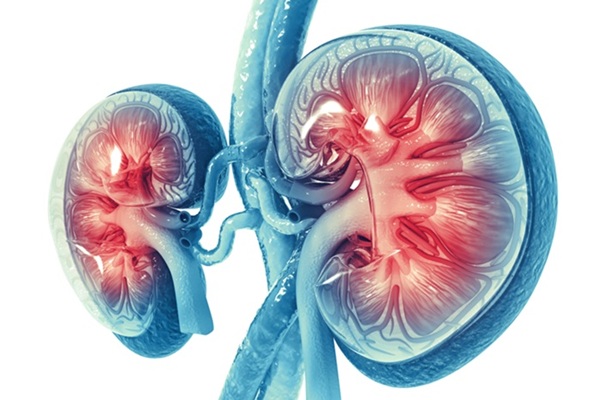Serum Based Antigen Test Detects Childhood Tuberculosis
|
By LabMedica International staff writers Posted on 01 Jun 2021 |

Image: Computer-generated Mycobacterium tuberculosis bacteria, Ziehl-Neelsen stain. The reagents used are carbol fuchsin, acid alcohol, and methylene blue counterstain Acid-fast bacilli stain red and the background is blue (Photo courtesy of microbiologyinpictures)
Approximately one million children develop tuberculosis (TB) and 205,000 die of TB-related causes each year. Eighty percent of these deaths occur in children < 5 years old, with the majority (96%) of deaths occurring among children who did not receive treatment, where missed diagnoses are likely responsible for undertreatment.
Children with TB, particularly infants, frequently have paucibacillary TB, exhibit non-specific symptoms, and are likely to rapidly progress to disseminated or extrapulmonary TB in the absence of appropriate treatment. This clinical presentation, combined with difficulty obtaining respiratory samples, makes it challenging to diagnose pediatric TB and monitor treatment responses using standard sputum-based methods.
A multidisciplinary team of medical scientists led by Tulane University School of Medicine (New Orleans, LA, USA) used a small blood sample that can be easily obtained from children of any age to detect a specific protein (CFP-10) that the bacteria secrete to maintain the infection that develops into TB. Since this protein is present at very low levels in the blood, the assay uses an antibody specific for this protein to enrich it from other proteins in blood and a mass spectrometer to detect it with high sensitivity and accuracy.
The team used this test to screen stored blood samples collected from 284 HIV-infected and 235 children without the virus who participated in a large clinical trial conducted from 2004 to 2008. Serum CFP-10pep was analyzed using a nanoparticle-based immunoenrichment assay read by matrix assisted laser desorption ionization-time of flight mass spectrometry (MALDI-TOF-MS) (Bruker Microflex LRF, Bremen, Germany) that detects Mtb-specific CFP-10pep from trypsin-digested serum or EDTA plasma samples.
The group found their test identified children diagnosed with TB by the current gold-standard TB tests with 100% accuracy. The assay also detected 83.7% of TB cases that were missed by these tests, but that were later diagnosed by a standard checklist employing an array of other information collected by each child's physician (unconfirmed TB cases). The test also detected CFP-10 in 77% of the blood samples that were collected 24 weeks before children were diagnosed with TB by other methods, indicating its strong potential for early TB diagnosis. The biomarker from some positive cases can be detected as early as 60 weeks before their TB diseases were confirmed.
Tony Y. Hu, PhD, a Professor of Biochemistry and Molecular Biology and senior author of the study, said, “This is a breakthrough for infants with tuberculosis because we don't have this kind of screening technology to catch early infections among those youngest groups who are most likely to be undiagnosed. I hope this method can be pushed forward quickly to reach these children as early as possible.”
The authors concluded that their results suggest that serum CFP-10pep signal could improve TB diagnosis in children, as it exceeds the WHO-specified sensitivity requirements for new non-sputum diagnostics, and exhibits similar performance for all TB manifestations, including culture-negative TB, HIV/TB co-infection, and extrapulmonary TB, which are normally challenging to diagnose. The study was published on May 18, 2021 in the journal BMC Medicine.
Related Links:
Tulane University School of Medicine
Bruker
Children with TB, particularly infants, frequently have paucibacillary TB, exhibit non-specific symptoms, and are likely to rapidly progress to disseminated or extrapulmonary TB in the absence of appropriate treatment. This clinical presentation, combined with difficulty obtaining respiratory samples, makes it challenging to diagnose pediatric TB and monitor treatment responses using standard sputum-based methods.
A multidisciplinary team of medical scientists led by Tulane University School of Medicine (New Orleans, LA, USA) used a small blood sample that can be easily obtained from children of any age to detect a specific protein (CFP-10) that the bacteria secrete to maintain the infection that develops into TB. Since this protein is present at very low levels in the blood, the assay uses an antibody specific for this protein to enrich it from other proteins in blood and a mass spectrometer to detect it with high sensitivity and accuracy.
The team used this test to screen stored blood samples collected from 284 HIV-infected and 235 children without the virus who participated in a large clinical trial conducted from 2004 to 2008. Serum CFP-10pep was analyzed using a nanoparticle-based immunoenrichment assay read by matrix assisted laser desorption ionization-time of flight mass spectrometry (MALDI-TOF-MS) (Bruker Microflex LRF, Bremen, Germany) that detects Mtb-specific CFP-10pep from trypsin-digested serum or EDTA plasma samples.
The group found their test identified children diagnosed with TB by the current gold-standard TB tests with 100% accuracy. The assay also detected 83.7% of TB cases that were missed by these tests, but that were later diagnosed by a standard checklist employing an array of other information collected by each child's physician (unconfirmed TB cases). The test also detected CFP-10 in 77% of the blood samples that were collected 24 weeks before children were diagnosed with TB by other methods, indicating its strong potential for early TB diagnosis. The biomarker from some positive cases can be detected as early as 60 weeks before their TB diseases were confirmed.
Tony Y. Hu, PhD, a Professor of Biochemistry and Molecular Biology and senior author of the study, said, “This is a breakthrough for infants with tuberculosis because we don't have this kind of screening technology to catch early infections among those youngest groups who are most likely to be undiagnosed. I hope this method can be pushed forward quickly to reach these children as early as possible.”
The authors concluded that their results suggest that serum CFP-10pep signal could improve TB diagnosis in children, as it exceeds the WHO-specified sensitivity requirements for new non-sputum diagnostics, and exhibits similar performance for all TB manifestations, including culture-negative TB, HIV/TB co-infection, and extrapulmonary TB, which are normally challenging to diagnose. The study was published on May 18, 2021 in the journal BMC Medicine.
Related Links:
Tulane University School of Medicine
Bruker
Latest Technology News
- Cell-Sorting Device Uses Electromagnetic Levitation to Precisely Direct Cell Movement

- Embedded GPU Platform Enables Rapid Blood Profiling for POC Diagnostics
- Viral Biosensor Test Simultaneously Detects Hepatitis and HIV
- Acoustofluidic Device to Transform Point-Of-Care sEV-Based Diagnostics
- AI Algorithm Assesses Progressive Decline in Kidney Function
- Taste-Based Influenza Test Could Replace Nasal Swabs with Chewing Gum
- 3D Micro-Printed Sensors to Advance On-Chip Biosensing for Early Disease Detection
- Hybrid Pipette Combines Manual Control with Fast Electronic Aliquoting
- Coral-Inspired Capsule Samples Hidden Bacteria from Small Intestine
- Rapid Diagnostic Technology Utilizes Breath Samples to Detect Lower Respiratory Tract Infections
Channels
Clinical Chemistry
view channel
VOCs Show Promise for Early Multi-Cancer Detection
Early cancer detection is critical to improving survival rates, but most current screening methods focus on individual cancer types and often involve invasive procedures. This makes it difficult to identify... Read more
Portable Raman Spectroscopy Offers Cost-Effective Kidney Disease Diagnosis at POC
Kidney disease is typically diagnosed through blood or urine tests, often when patients present with symptoms such as blood in urine, shortness of breath, or weight loss. While these tests are common,... Read moreMolecular Diagnostics
view channel
Urine Test Detects Early Stage Pancreatic Cancer
Pancreatic cancer remains among the hardest cancers to detect early. In the UK, around 10,000 people are diagnosed each year, but only 5% survive beyond five years. Late diagnosis is a major factor—more... Read more
Genomic Test Could Reduce Lymph Node Biopsy Surgery in Melanoma Patients
Accurately determining whether melanoma has spread to the lymph nodes is crucial for guiding treatment decisions, yet the standard procedure—sentinel lymph node biopsy—remains invasive, costly, and unnecessary... Read moreHematology
view channel
ADLM’s New Coagulation Testing Guidance to Improve Care for Patients on Blood Thinners
Direct oral anticoagulants (DOACs) are one of the most common types of blood thinners. Patients take them to prevent a host of complications that could arise from blood clotting, including stroke, deep... Read more
Viscoelastic Testing Could Improve Treatment of Maternal Hemorrhage
Postpartum hemorrhage, severe bleeding after childbirth, remains one of the leading causes of maternal mortality worldwide, yet many of these deaths are preventable. Standard care can be hindered by delays... Read more
Pioneering Model Measures Radiation Exposure in Blood for Precise Cancer Treatments
Scientists have long focused on protecting organs near tumors during radiotherapy, but blood — a vital, circulating tissue — has largely been excluded from dose calculations. Each blood cell passing through... Read moreImmunology
view channel
Blood-Based Liquid Biopsy Model Analyzes Immunotherapy Effectiveness
Immunotherapy has revolutionized cancer care by harnessing the immune system to fight tumors, yet predicting who will benefit remains a major challenge. Many patients undergo costly and taxing treatment... Read more
Signature Genes Predict T-Cell Expansion in Cancer Immunotherapy
Modern cancer immunotherapies rely on the ability of CD8⁺ T cells to rapidly multiply within tumors, generating the immune force needed to eliminate cancer cells. However, the biological triggers behind... Read morePathology
view channel
New Molecular Analysis Tool to Improve Disease Diagnosis
Accurately distinguishing between similar biomolecules such as proteins is vital for biomedical research and diagnostics, yet existing analytical tools often fail to detect subtle structural or compositional... Read more
Tears Offer Noninvasive Alternative for Diagnosing Neurodegenerative Diseases
Diagnosing and monitoring eye and neurodegenerative diseases often requires invasive procedures to access ocular fluids. Ocular fluids like aqueous humor and vitreous humor contain valuable molecular information... Read moreTechnology
view channel
Cell-Sorting Device Uses Electromagnetic Levitation to Precisely Direct Cell Movement
Sorting different cell types—such as cancerous versus healthy or live versus dead cells—is a critical task in biology and medicine. However, conventional methods often require labeling, chemical exposure,... Read more
Embedded GPU Platform Enables Rapid Blood Profiling for POC Diagnostics
Blood tests remain a cornerstone of medical diagnostics, but traditional imaging and analysis methods can be slow, costly, and reliant on dyes or contrast agents. Now, scientists have developed a real-time,... Read moreIndustry
view channel
Qiagen Acquires Single-Cell Omics Firm Parse Biosciences
QIAGEN (Venlo, Netherlands) has entered into a definitive agreement to fully acquire Parse Biosciences (Seattle, WA, USA), a provider of scalable, instrument-free solutions for single-cell research.... Read more
Puritan Medical Products Showcasing Innovation at AMP2025 in Boston
Puritan Medical Products (Guilford, ME, USA), the world’s most trusted manufacturer of swabs and specimen collection devices, is set to exhibit at AMP2025 in Boston, Massachusetts, from November 11–15.... Read more
Advanced Instruments Merged Under Nova Biomedical Name
Advanced Instruments (Norwood, MA, USA) and Nova Biomedical (Waltham, MA, USA) are now officially doing business under a single, unified brand. This transformation is expected to deliver greater value... Read more






















